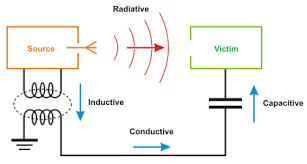Glossary of Printed Circuit Board starts with letter A
There are lots of words related to PCB which a PCB designer need to know for their use. Here I am trying to explain those words..
Active component —1. A component
which adds energy to the signal it passes. 2. A device that requires an
external source of power to operate upon its input signal(s). 3. Any device
that switches or amplifies by the application of low-level signals.
Examples of active devices which fit one or more of the
above definitions: transistors, rectifiers, diodes, amplifiers, oscillators,
mechanical relays and almost all IC's
AlN —Aluminum Nitride, a
compound of aluminum with nitrogen.
AlN Substrate —A substrate of aluminum nitride.
Alumina —A ceramic used for insulators in electron
tubes or substrates in thin-film circuits. It can withstand continuously high temperatures and has
a low dielectric loss over a wide frequency range. Aluminum oxide
(Al 2 O 3 )
Analog circuit — A circuit in which
the output varies as a continuous function of the input, as contrasted
with digital circuit.
Anode —1.
The positive element such as the plate of a vacuum tube; the element to
which the principal stream of electrons flows. 2. In a cathode-ray tube,
the electrodes connected to a source of positive potential. These anodes are
used to concentrate and accelerate the electron beam for focusing.
Aperture—1. An indexed shape with a specified x and y
dimension, or line-type with a specified width, used as a basic element or
object by a photoplotter in plotting geometric patterns on film. The index of
the aperture is its Position (a number used in an aperture list to identify an aperture)
or D code . 2. A small, thin, trapezoidal piece of plastic used to limit
and shape a light source for plotting light patterns on film, and mounted in a
mechanical disk called an " aperture wheel" which in turn is mounted on the lamp
head of a vector photoplotter. An aperture is mostly
opaque, but with a transparent portion that controls the size and shape of the
light pattern. A vector photoplotter plots images from a CAD database on photographic film in a darkroom by
drawing each line with a continuous lamp shined through an annular-ring aperture,
and creating each shape (or pad) by flashing the lamp through a specially sized and shapedaperture.
3. A line of textual data in an aperture list describing the
index names (D code and position), the shape, the usage (flash or draw) and the
X and Y dimensions of an aperture. Some aperture lists leave out
certain of those types of data. For example, laser photoplotters don't need to
know whether an aperture is a flash or draw, so a modern-day aperture list
might leave that datum out.
Aperture list —1. An ASCII text data file which describes the size and shape of
the apertures used by a photoplotter for any one photoplot. 2. A print-out of
this file. 3. A binary version of this file. [Also called "aperture
table."]
Aperture table — Aperture list
Aperture wheel —A component of a Vector photoplotter , it is a metal disk having cut-outs with
brackets and screw holes arranged near its rim for attaching apertures . Its center hole is attached to a motorized spindle on the lamp
head of the photoplotter. When a D code denoting a particular position on the wheel is retreived from
a Gerber File by the photoplotter, the wheel is caused to
rotate so that the aperture in that position is placed between the lamp and the
film.
In preparation for a photoplotting, the
aperture wheel is set up by a technician who reads a printed aperture list, selects the correct aperture from a set of
them stored in a box with compartments and, using a small screw driver,
installs the aperture onto the position on the wheel which is called for on the
list. This process is subject to human error and is one of the disadvantages of
vector photoplotters as compared with laser photoplotter.
Artwork —Artwork for printed circuit design is
photoplotted film (or merely the Gerber files used to drive the photoplotter),
NC Drill file and documentation which are all used by a board house to
manufacture a bare printed circuit board.
ASCII —
American Standard Code for Information Interchange. A text and
control-code character set used in computers. Pronounced
"ASS-key."
Assembly —1. The process of positioning and
soldering components to a PCB 2. Act or process of fitting together parts to make
a whole. .
Assembly drawing —A drawing depicting
the locations of components, with their reference designator, on a printed circuit. Also called
"component locator drawing."
Assembly house —A manufacturing
facility for attaching and soldering components to a printed circuit.
ASTM —American
Society of Testing and Materials.
ATE —Automatic Test
Equipment.
AWG —American Wire
Gauge. A PCB Designer needs to know diameters of wire gauges to properly
size E-Pads. The American Wire Gauge, formerly known as the Brown and
Sharpe (B + S) Gauge, originated in the wire drawing industry. The gauge
is calculated so that the next largest diameter always has a cross-sectional
area that is 26% greater.
Auto-router —automatic router, a computer program
that routes a PC board design (or a silicon chip design) automatically.
In this article I have tried to explain the meaning of the words starts with A.
Thanks for Reading my Article.


Comments
Post a Comment